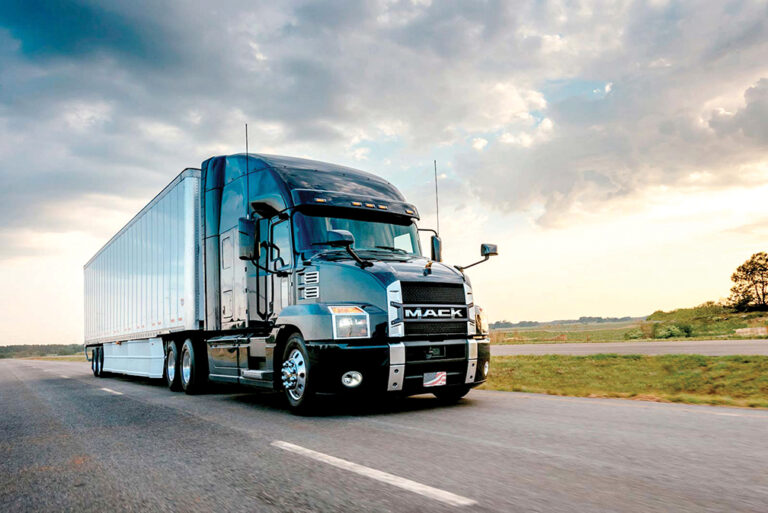The long wait for delivery of a new Class 8 truck rose again in October, reaching 14.6 months if production continues at the same rate.
“It’s because of the global everything shortage that is impacting the supply chain,” explained Kenny Vieth, president and senior analyst at ACT Research. “It’s semiconductors, and it’s resins and wood, and aluminum and certain steels, and the gamut of parts.”
The October backlog of trucks waiting to be built reached 280,900.
Under normal circumstances, truck OEMs (original equipment manufacturers) in North America should be able to produce 28,000 to 30,000 new trucks each month. In October, they produced only 19,260, according to data supplied by Vieth and ACT Research.
“Eventually, the build rate will climb,” Vieth said. But no one knows when.
If production returned to full capacity right now, it would still take more than nine months just to clear out the backlog.
U.S. sales of new Class 8 trucks in October were 17,486, down just 0.4% from September sales of 17,565 trucks. Compared to October of 2020, sales dropped 8.1% from 19,034 sold in that month.
For perspective, during the four-month period of July through October this year, U.S. truck sales totaled 70,977. During the same four months of 2020, as the economy was coming out of recession, 71,196 trucks were sold. In 2019, prior to COVID-19 and the economic problems brought by the pandemic, 101,463 trucks were sold.
In October, 12,901 (73.8%) of the trucks sold were fifth-wheel equipped road tractors, with the remaining 4,585 (26.2%) destined for vocational uses such as dump, trash or concrete.
When production is slowed, OEMs can often rely on inventories to fill orders. Inventories, however, are now at record low levels. Inventories also include trucks waiting for vocational modifications and trucks in transit — all of which are already spoken for, leaving few available for purchase.
There’s no help from the used truck market, either. U.S. sales of used trucks were down 24% in October compared to October 2020, according to ACT’s “State of the Industry: U.S. Classes 3-8 Used Trucks.” It isn’t because potential buyers aren’t shopping; it’s because the trucks simply aren’t there to sell.
If you find a used truck to purchase, be prepared for sticker shock. Used truck prices rose 5% from August to September, and another 3% in October. The average used truck sold was a whopping 67% more expensive than in October 2020.
“When trucks are plentiful, potential buyers have the luxury of shopping for the truck that most closely meets their requirements,” said Steve Tam, vice president of ACT. “Conversely, when scarcity reigns, buyers are often left with limited, or perhaps no, choice.”
Tam also suggested that with both demand and pricing at such high levels, some sellers may choose to remarket their used equipment themselves, selling their trucks outright instead of trading them in. Potential buyers may benefit by checking with carriers who run equipment that might fit their needs.
One issue with used equipment is that breakdowns can be more likely than with a new truck. OEMs aren’t the only customers with supply chain problems. Repair facilities are also experiencing long waits for parts, if they can obtain them at all, adding to the anxiety over buying a truck.
While the shortage of both new and used trucks creates a problem for potential buyers, trucks that are running are still finding freight rates at or near record levels. That’s because the supply of trucks isn’t sufficient to meet the demand, so shippers are willing to pay more to get their goods moved.
In a typical economy, the trucking industry responds to higher rates by buying more trucks. Eventually, the number of available trucks exceeds the demand for them, and rates begin to fall. The industry experiences cycles of favorable and unfavorable conditions.
But what happens when there aren’t enough trucks available to buy? The capacity crunch continues, and rates remain high. The “up” cycle of favorable conditions for trucking continues until truck numbers increase or freight volumes fall.
October sales reported by individual OEMs were mixed, likely impacted by snags in the supply chain. While overall sales of Class 8 trucks fell by less than half a percent, sales at OEMs were more volatile. Kenworth sales, for example, fell by 21.7% in October compared to September, while Peterbilt sales rose by 18.8% for the same period. Volvo sales increased by 14.4%, while Mack sales fell 18.4%.
According to data received from Wards Intelligence, Freightliner sales were the steadiest in the U.S. market. The OEM reported October sales of 6,520 Class 8 trucks, a decline of 2.7% from sales of 6,703 the prior month. Compared to October 2020, sales declined 11.1% from 6,703.
Peterbilt’s 2,270 sold topped September’s 1,910 by 18.8% but was 15.9% down from last October’s 2,699 trucks sold. Kenworth sold 2,055 trucks in October, down 21.7% from September’s 2,625 and down 28.1% from last October, when the company sold 2,859 trucks.
International saw a 13.3% increase in sales, from 2,080 in September to 2,356 in October. Compared to October 2020, sales dipped by 0.9% from 2,377.
Volvo trucks gained 14.4% with October sales of 1,959, compared to 1,713 for September. Compared to October 2020, sales grew by a mere 16 trucks (0.8%). Mack truck sales of 1,278 trailed September sales of 1,566 by 18.4% but were still 18.7% better than the 1,077 sold in October 2020.
Western Star increased sales in October by 30 trucks, selling 564 compared to 534 for a 5.6% increase. Compared to October of last year, sales increased by 16.5% from 484 sold in that month.
Year-to-date U.S. market share for new, Class 8 truck is currently 38.3% for Freightliner, 14.7% Peterbilt, 14.5% Kenworth, 12.7% International, 9.1% Volvo, 8.0% Mack and 2.7% Western Star.
While supply-chain issues continue, trucks aren’t likely to be any easier to find in the coming months, but conditions for making money will remain favorable for those who are running.
Cliff Abbott is an experienced commercial vehicle driver and owner-operator who still holds a CDL in his home state of Alabama. In nearly 40 years in trucking, he’s been an instructor and trainer and has managed safety and recruiting operations for several carriers. Having never lost his love of the road, Cliff has written a book and hundreds of songs and has been writing for The Trucker for more than a decade.








